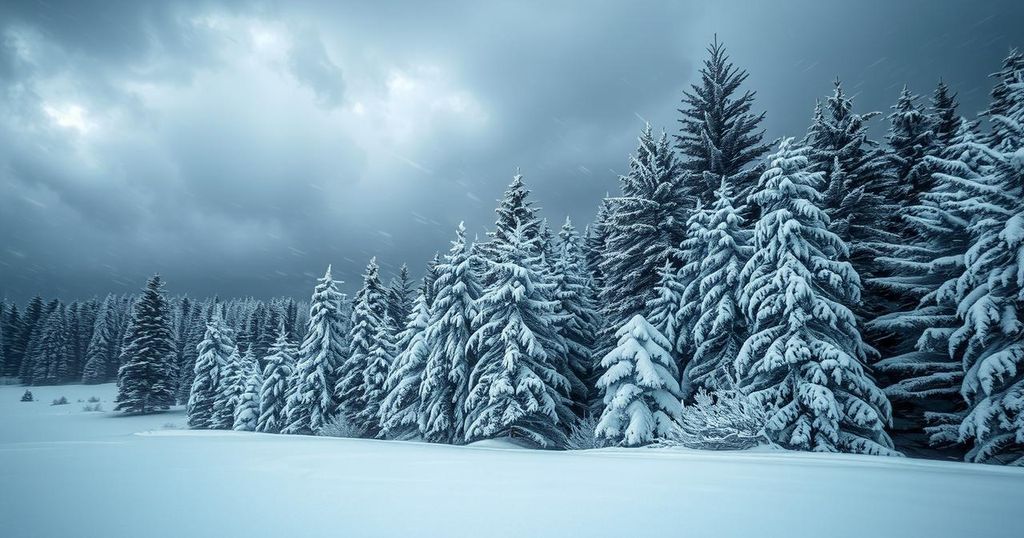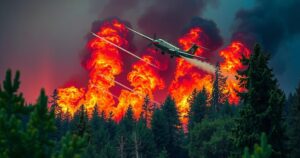Severe Winter Storms Impact Large Areas of the Eastern U.S. and California

A powerful winter storm is affecting a 1,500-mile region in the eastern U.S., with additional storms expected to follow. Snow, ice, and rain are leading to hazardous travel and power outages, particularly in Virginia, while Southern California faces serious flooding risks. The situation highlights a continued pattern of disruptive winter weather across the country.
A significant winter storm is impacting a vast 1,500-mile region of the eastern United States, marking the first of three consecutive winter storms for the week. This storm is bringing heavy snow, ice, and rain to various areas, including a notable snowfall predicted for Chicago, along with substantial flooding risks in Southern California. These storms are part of a series that has been ongoing since the beginning of February.
As the storm progresses, snow accumulations are expected, particularly in the Tennessee Valley and the Appalachian region, already seeing 1 to 3 inches of snowfall. Washington, D.C., faces potential snowfall of up to 6 inches, which may severely disrupt travel during the busy afternoon commute. State officials in Virginia have declared a state of emergency, urging residents to remain off the roads during this storm event.
There is a significant risk of power outages and hazardous travel due to ice accumulations exceeding 0.25 inches across parts of West Virginia, Virginia, and North Carolina. The National Weather Service has cautioned that these ice conditions could render many roads impassable and lead to numerous power outages as branches and lines become weighed down.
The ongoing storm, which is currently causing snowfall, is impacting areas previously spared from such wintry conditions. The band of snowfall is moving through the Appalachians, depositing heavy snow in expected regions, including D.C., which has already seen remarkable snowfall totals over the last couple of months. Rainstorms are also affecting southern areas, creating flooding risks across a broad region extending from Texas to the Carolinas.
The following winter storm is anticipated to form in the central United States while the first continues to impact the East and southern rain. As it expands on Wednesday, significant wintry precipitation is expected in the Midwest and parts of the Northeast, culminating in substantial snowfall in cities like Kansas City and Chicago, where totals could reach double digits.
Moreover, the storm could generate significant ice formations in areas south of the heaviest snow locations. A degree of icing is possible from Oklahoma through the Ohio Valley. The Southern states will also see an increase in rainfall, with thunderstorms potentially turning severe in Louisiana, Mississippi, and Alabama toward the middle of the week.
The third storm is poised to strike California first with substantial rain spread across the state’s coastline early Thursday morning. Due to its strength, flooding rainfall is expected, with regions that have experienced recent wildfires being particularly at risk. Authorities in California have taken measures to mitigate potential debris flows in burn areas, while heavy snowfall is forecasted for the Sierra Nevada mountains.
As the storm moves eastward, it will expand its impact through the Midwest and into the Northeast by the weekend, with the threat of mixing precipitation. The warm side of this system will also see heavy rain and possible severe thunderstorms, with the storm system expected to continue affecting the East Coast into Sunday and concluding early Monday. Beyond this, forecasts suggest that another winter storm may emerge mid-next week, continuing the pattern of winter weather events.
In summary, the eastern United States is grappling with a powerful winter storm that is part of a series of storms expected this week. With heavy snowfall, ice, and significant rainfall, states are on alert for hazardous travel conditions and power outages. Meanwhile, California faces its own flooding risks, particularly in areas recovering from wildfires. The subsequent storms will likely exacerbate these conditions into the weekend and beyond.
Original Source: www.kten.com







